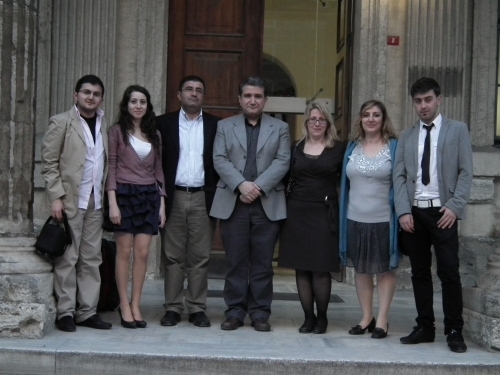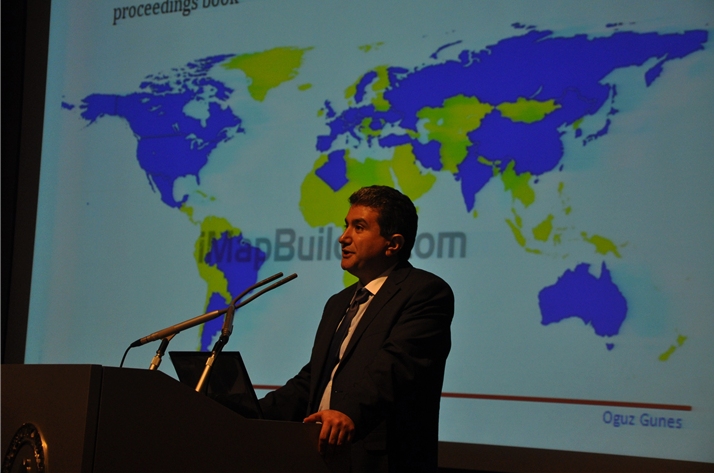Atılım University-supported International NDTMS-2011 Symposium held at ITU
31.05.2011
The International Symposium on Nondestructive Testing of Materials and Structures (NDTMS-2011) was held for the first time at Istanbul Technical University’s Süleyman Demirel Cultural Center on May 15-18, 2011. The symposium was co-organized by the International Union of Laboratories and Experts in Construction Materials, Systems and Structures (RILEM), co-sponsored by the American Society for Nondestructive Testing (ASNT), and supported by several prestigious academic and research institutions including the Massachusetts Institute of Technology (MIT, USA), BAM (Germany), University of Edinburgh (U.K.), University of Stuttgart (Germany), the Technical University of Munich (Germany) and Politecnico di Milano(Italy). Several national universities lead by Atılım University provided scientific and sponsorship support for the symposium. Widely participated by NDT experts, researchers and practitioners from all around the World, NDTMS-2011 reflected the state of the art in NDT research and practice in the World.
Nondestructive testing (NDT) and evaluation (NDE) can be defined in a broad sense as the characterization of certain physical properties of materials or detection and location of anomalies within materials and structures using techniques that will not inflict any significant damage to the material or structure. The concern about the deteriorating nature of the World’s infrastructures and the need for the assessment of structural materials and systems make the development and implementation of nondestructive testing and evaluation methodologies a necessity. Although research on NDT in engineering may have a history of more than 60 years, early developments primarily referred to metals and metal components. With the technological advances in the areas related to NDT and increasing number of engineering structures, NDT methods have also been required for the quality control and condition assessment of building structures and materials as a basis for repair, retrofit and strengthening.

Betoscan Multisensor Platform (left) ultrasonic thickness measurement and results (right) (www.betoscan.bam.de)
Several NDT techniques which are known in metallurgy, medical diagnostics, aviation and aerospace, and geophysical applications have been adopted and further developed for use in the condition assessment of structures and construction materials. Recent advances in NDT methodologies for materials and structures combined with the increased speed and memory of computers and development of efficient imaging algorithms have led to the processing of measured responses from NDT to better characterize materials and determine the spatial extent of the anomalies in two or three dimensions as well as the nature of such anomalies.

Spacetec tunnel inspection: principle of laser scanner (left) tunnel surfer as measured with laser (middle) thermographic image superimposed (right) (www.spacetec.de)
Pursuant to these developments and considering the need to foster ideas and identify efficient application techniques, NDTMS-2011 at ITU was organized. The symposium provided a forum of engineers, researchers, and professionals for the exchange of ideas and knowledge on NDT with applications in civil and other engineering fields. A distinguishing quality of the symposium was that it not only captured the state of the art in NDT of materials and structures through papers by leading experts, but also provided informative descriptions of ongoing NDT research and development in diverse areas as well as field experiences by practicing engineers.
NDT/NDE is a highly multi-disciplinary field involving various scientific disciplines, innovative theoretical and experimental techniques, and advanced computational modeling and imaging. Therefore, there is a need to bridge the gaps between these various aspects, as well as the gap between the developers and the practicing engineers. NDTMS-2011 represented a unifying theme contributing to the closing of these gaps to some extent. The large number of abstracts and papers received for consideration to be included in the symposium attests to the importance of the subject and the need for further developments. The symposium included 175 papers contributed by 473 authors from 36 countries around the world. The two-part proceedings book is in the publication process as a RILEM Bookseries volume by Springer. It is only fitting that this symposium with such multi-national representation is held in a world city, Istanbul, with its profound history and rich culture as well as unique location between two continents, Europe and Asia.
The topics of the proceedings were organized as follows: NDT methods for the characterization of materials and structures; NDT for material and property characterization; early age NDT of concrete and other materials; NDT for metallic material characterization; NDT of metals and composites; theoretical modeling and simulation studies as a basis for NDT; NDT of civil infrastructures; geotechnical and geophysical applications of NDT; health monitoring of structures; NDT and evaluation of historic buildings and monuments; NDT planning, practice, reliability, codes and standards.
The organization of NDTMS-2011 was led by Prof. Oral Büyüköztürk (MIT, Chair), Prof. Mehmet Ali Taşdemir (ITU), Assoc. Prof. Yılmaz Akkaya (ITU) and Asst. Prof. Oğuz Güneş (Atılım University). The symposium was dedicated to Prof. Dr. M. Cengiz Dökmeci (ITU) for his contributions to the science of materials, continuum mechanics, and fundamental studies underpinning the development of nondestructive evaluation methods for materials and structures. During the symposium, the symposium chair Prof. Oral Büyüköztürk was presented with the prestigious “Mirko Ros Gold Medal” by Prof. Urs Meier on behalf of the Swiss EMPA Laboratories to honour his life’s work in Civil Engineering.


Aside from the Atılım University sponsorship and the substantial contributions by Dr. Oğuz Güneş from the Civil Engineering Department of Atılım University as the Local Organizing Committee Co-Chair and the Co-Editor of the proceedings book, several faculty members including Dr. Burcu Güneş, Dr. Ayhan Gürbüz, Dr. Seda Yeşilmen and Dr. Belgin İşgör made contributions through their papers, participation and service as session chairs while our students Halil İbrahim Andiç, Tutku Gözde Eren and Burak Çakır provided valuable assistance during the symposium. At the opening of the symposium, our Provost Prof. Dr. Hasan U. Akay was presented with a plaque by Prof. Dr. Oral Büyüköztürk in recognition of the institutional support provided by Atılım University.
The NDTMS-2011 organizing committees believe that the efforts of all those who have contributed to the symposium will be fruitful, and that the symposium and the proceedings book will contribute to the science, engineering, and practice of NDT for many years to come.
Nondestructive testing (NDT) and evaluation (NDE) can be defined in a broad sense as the characterization of certain physical properties of materials or detection and location of anomalies within materials and structures using techniques that will not inflict any significant damage to the material or structure. The concern about the deteriorating nature of the World’s infrastructures and the need for the assessment of structural materials and systems make the development and implementation of nondestructive testing and evaluation methodologies a necessity. Although research on NDT in engineering may have a history of more than 60 years, early developments primarily referred to metals and metal components. With the technological advances in the areas related to NDT and increasing number of engineering structures, NDT methods have also been required for the quality control and condition assessment of building structures and materials as a basis for repair, retrofit and strengthening.

Betoscan Multisensor Platform (left) ultrasonic thickness measurement and results (right) (www.betoscan.bam.de)

Spacetec tunnel inspection: principle of laser scanner (left) tunnel surfer as measured with laser (middle) thermographic image superimposed (right) (www.spacetec.de)
NDT/NDE is a highly multi-disciplinary field involving various scientific disciplines, innovative theoretical and experimental techniques, and advanced computational modeling and imaging. Therefore, there is a need to bridge the gaps between these various aspects, as well as the gap between the developers and the practicing engineers. NDTMS-2011 represented a unifying theme contributing to the closing of these gaps to some extent. The large number of abstracts and papers received for consideration to be included in the symposium attests to the importance of the subject and the need for further developments. The symposium included 175 papers contributed by 473 authors from 36 countries around the world. The two-part proceedings book is in the publication process as a RILEM Bookseries volume by Springer. It is only fitting that this symposium with such multi-national representation is held in a world city, Istanbul, with its profound history and rich culture as well as unique location between two continents, Europe and Asia.
The topics of the proceedings were organized as follows: NDT methods for the characterization of materials and structures; NDT for material and property characterization; early age NDT of concrete and other materials; NDT for metallic material characterization; NDT of metals and composites; theoretical modeling and simulation studies as a basis for NDT; NDT of civil infrastructures; geotechnical and geophysical applications of NDT; health monitoring of structures; NDT and evaluation of historic buildings and monuments; NDT planning, practice, reliability, codes and standards.
The organization of NDTMS-2011 was led by Prof. Oral Büyüköztürk (MIT, Chair), Prof. Mehmet Ali Taşdemir (ITU), Assoc. Prof. Yılmaz Akkaya (ITU) and Asst. Prof. Oğuz Güneş (Atılım University). The symposium was dedicated to Prof. Dr. M. Cengiz Dökmeci (ITU) for his contributions to the science of materials, continuum mechanics, and fundamental studies underpinning the development of nondestructive evaluation methods for materials and structures. During the symposium, the symposium chair Prof. Oral Büyüköztürk was presented with the prestigious “Mirko Ros Gold Medal” by Prof. Urs Meier on behalf of the Swiss EMPA Laboratories to honour his life’s work in Civil Engineering.


Aside from the Atılım University sponsorship and the substantial contributions by Dr. Oğuz Güneş from the Civil Engineering Department of Atılım University as the Local Organizing Committee Co-Chair and the Co-Editor of the proceedings book, several faculty members including Dr. Burcu Güneş, Dr. Ayhan Gürbüz, Dr. Seda Yeşilmen and Dr. Belgin İşgör made contributions through their papers, participation and service as session chairs while our students Halil İbrahim Andiç, Tutku Gözde Eren and Burak Çakır provided valuable assistance during the symposium. At the opening of the symposium, our Provost Prof. Dr. Hasan U. Akay was presented with a plaque by Prof. Dr. Oral Büyüköztürk in recognition of the institutional support provided by Atılım University.
The NDTMS-2011 organizing committees believe that the efforts of all those who have contributed to the symposium will be fruitful, and that the symposium and the proceedings book will contribute to the science, engineering, and practice of NDT for many years to come.

